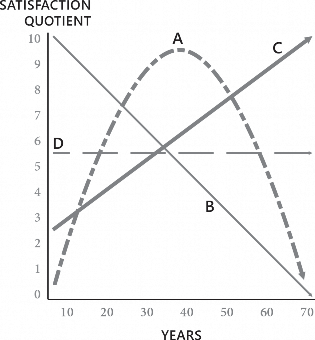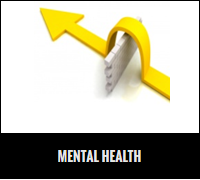Study: The Satisfaction Index
 Figure 2 The x-axis represents some of the decades in a human life span. The y-axis indicates the level of perceived or anticipated satisfaction during those years.I once conducted a survey that indirectly measured the level of anticipation with which individuals look forward to the coming years and decades. There was a total population of 288 people interviewed for this study with an age range of twenty-three to eighty-six, and to them I posed the following question: “If you had to draw life on a graph, from birth to death, and show where you believe life is at its peak (where it is at its most satisfying) and where it was at its lowest in satisfaction, how would you draw it?”
Figure 2 The x-axis represents some of the decades in a human life span. The y-axis indicates the level of perceived or anticipated satisfaction during those years.I once conducted a survey that indirectly measured the level of anticipation with which individuals look forward to the coming years and decades. There was a total population of 288 people interviewed for this study with an age range of twenty-three to eighty-six, and to them I posed the following question: “If you had to draw life on a graph, from birth to death, and show where you believe life is at its peak (where it is at its most satisfying) and where it was at its lowest in satisfaction, how would you draw it?”
The results of this survey are included here as evidence because I believe that with the full development of the self comes real power, satisfaction, and happiness. I believe this stage of life should be eagerly anticipated and looked forward to. Instead, many people today are simply happy to be alive and healthy.
A. Dashed, bell-shaped line.
Seventy-three percent of the participants interviewed subscribed to this view of life and satisfaction. It starts at around one on the Satisfaction Index and peaks between thirty and fifty years and then steadily declines. Their age range was from twenty-three to sixty-nine.
These individuals felt that there comes a time, somewhere between thirty and fifty years of age, when life starts to become a downhill experience. Irrespective of their ages, they were unanimous in not really looking forward to aging, and certainly not to the next decade. They felt being a child or teenager was too powerless because they had few choices, if any, and even the lack of responsibilities did not make the prospect more attractive. They also felt that the whole aging process, except for things like greater material wealth or security and higher career achievements, was still by and large a negative experience. They would have preferred to stay young, between twenty and thirty.
B. Solid, descending line.
Twelve percent of the participants interviewed subscribed to this view of life and satisfaction. It starts at ten on the Satisfaction Index and goes steadily down through seventy to eighty years of age. This group consisted of participants aged thirty to eighty-three.
Their notion was that life could not possibly be any better than when you and your every need are taken care of. You are also loved more than for the rest of your life. The rest of life after infancy and childhood is an ever-escalating series of struggles, disappointments,and responsibilities, ending with slowly eroding physical and mental capacity.
C. Solid, inclined line.
Ten percent of those interviewed subscribed to this view of life. It starts at around three on the Satisfaction Index and goes steadily upward as we age. This group was aged from sixty-five to eighty-six.
These participants reasoned that as you age, you tend to accept things the way they are. You let go of your dreams and become more realistic. Eventually, the kids grow up and leave, reducing parental responsibilities, and ultimately, you can retire and not have to work. They considered retirement the high point of life and worth looking forward to so they could do the things they always wanted — reading, traveling, watching the grandchildren, and so on.
D. Dashed, level line.
This group represented about five percent of the total interviewed. It starts at around five on the Satisfaction Index and stays there.
Participants who chose this were aged between thirty-five and seventy-two. Their reasoning went like this: life always has its ups and downs, so it doesn’t really get any worse or better. Perhaps with age, we get to handle our problems more effectively. Life is what you make it.








